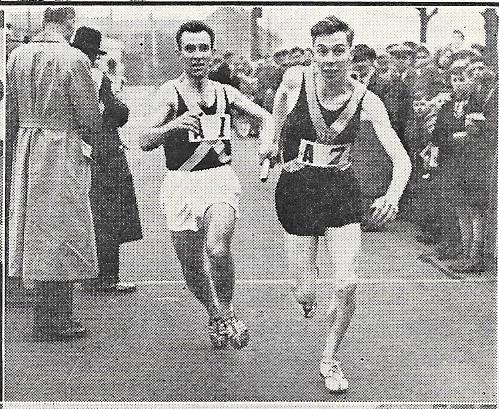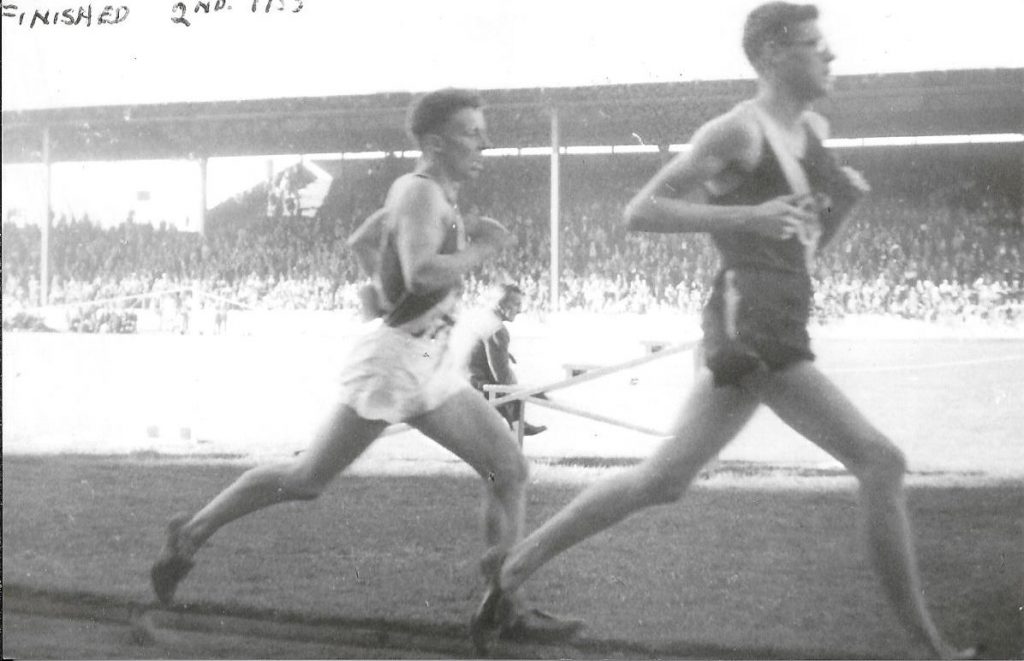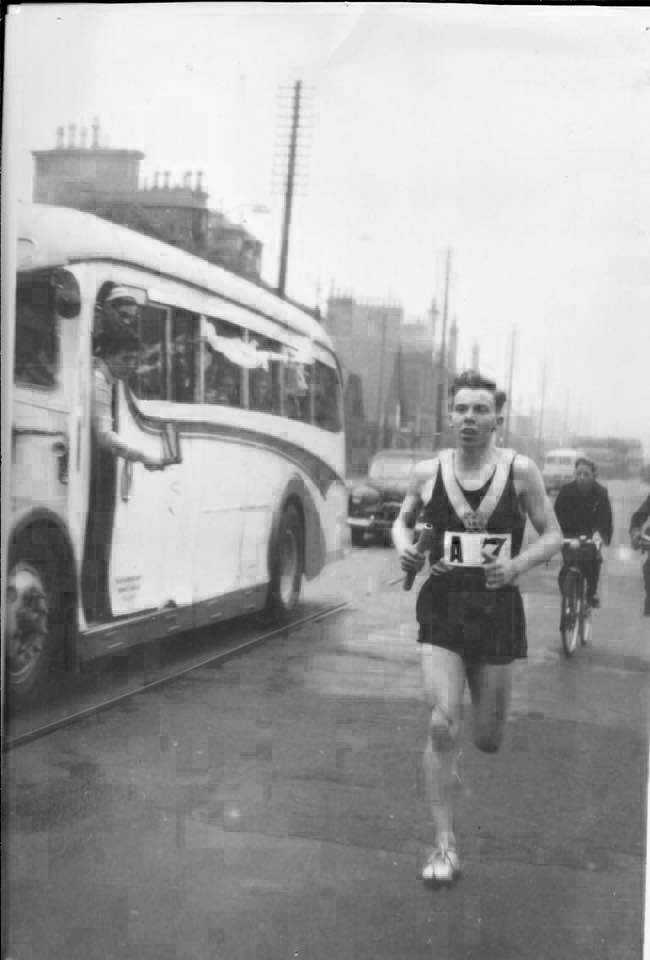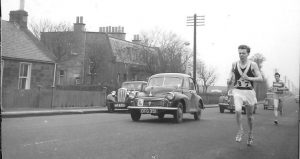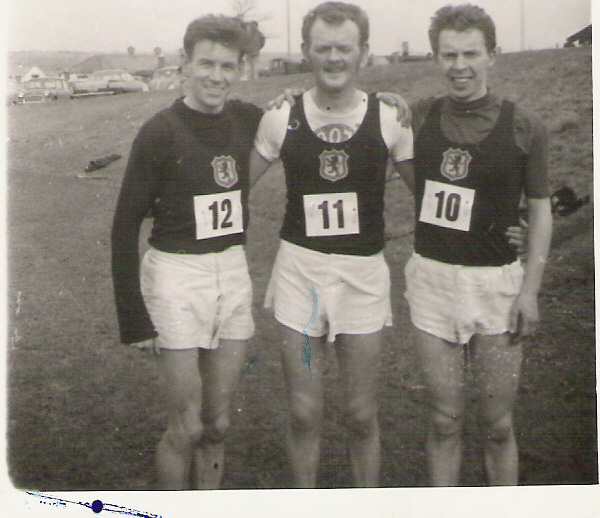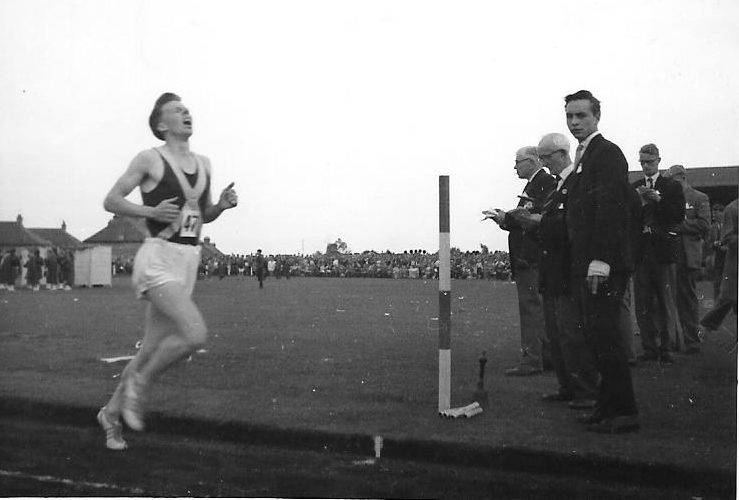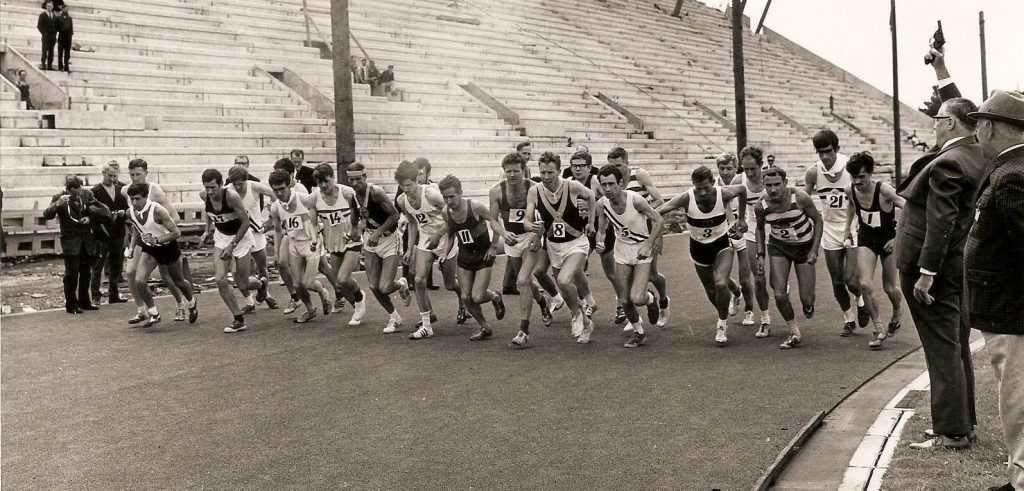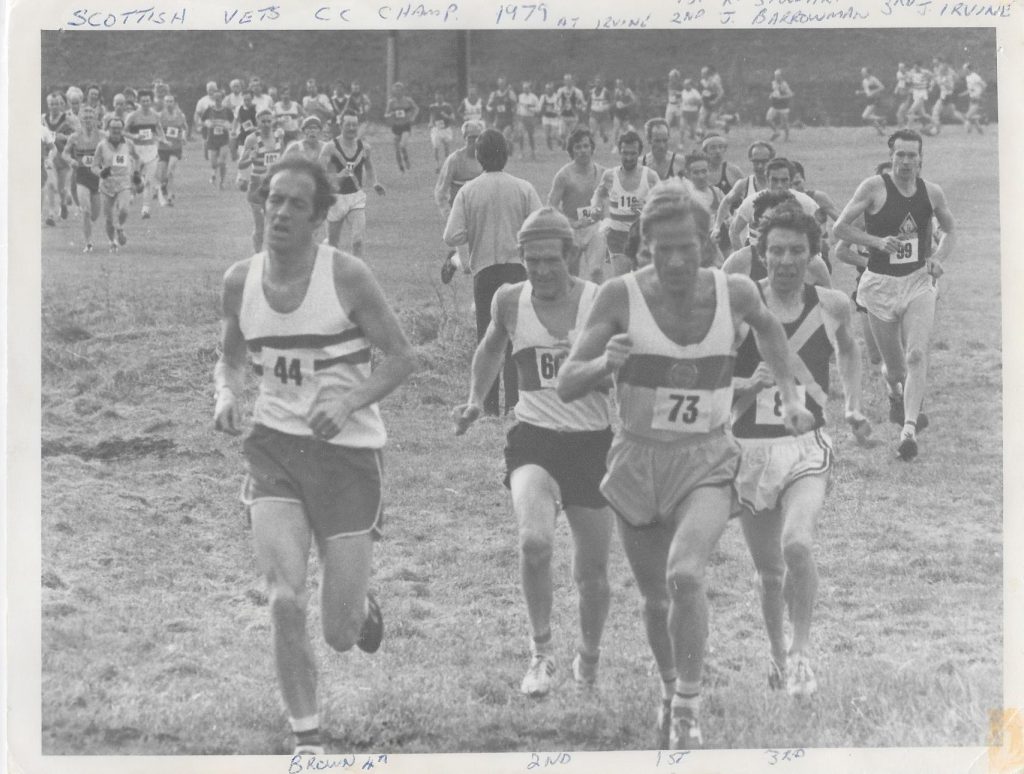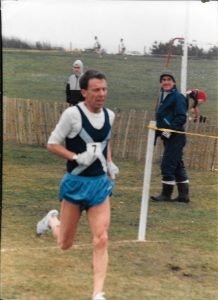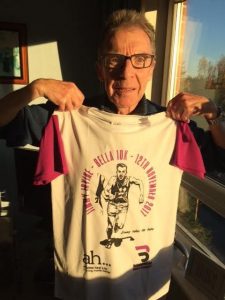Jim taking over from Harry Fenion in the Edinburgh to Glasgow, 1958
Jim Irvine was born on 15th February 1935, first appeared in the national cross-country championships on 1st March 1952 at the age of 16 and has only ever run for one club – Bellahouston Harriers. He assisted the club to win gold, silver and bronze medals on the road and over the country locally, at District level and nationally. Jim was a real runner in the traditional Scottish fashion, racing almost every weekend all winter – he turned out in the McAndrew Relays, the District relays, the County relays, the Glasgow University road race, the Edinburgh to Glasgow relay, the Nigel Barge New Year race, the County championship and all the other major championships. And that was almost every year for several decades. He was unfortunately never selected for an international team – representative matches were very few and far between in the 1950’s and 60’s – but still managed to perform at a high level for twelve months a year for many years. Every sport needs men like Jimmy, men who are becoming harder to find. His career deserves to be looked at quite closely.
The winter competition season was quite well structured although there were fewer races than now. Jim ran in them all though: the McAndrew relay was always on the first Saturday in October, then there were the County and District Relays before the eight man Edinburgh to Glasgow on the third weekend in November and maybe County championships in December. The Beith New Year’s Day relay was followed by the Nigel Barge road race on the first Saturday of the New Year, then the District Championships and the National Championship at the end of February or start of March ended the domestic season. We will concentrate on the main championships and relays.
Jimmy remembers his Uncle, Harry K. Duff, who was a real character and a great inspiration. Harry won medals in the E to G, while he was running for Plebeian Harriers. In 1933 he ran the last leg and his team won gold. In 1935 it was bronze and Harry set the fastest time on the third leg. He gained another bronze in 1936, when he ran the third leg again. In the 1934 Senior National XC, Plebeian finished first equal on points with Dundee Thistle, but lost the title on countback – so Harry gained a silver medal. Harry Duff was a very good runner. He joined the Army when WW2 started and Jimmy doesn’t think he ran after the War, although Uncle Harry used to tell fascinating stories about ‘The Great Plebs’.
Jimmy, himself, joined Bellahouston Harriers in July 1950 as a sprinter but was told that he had a good style for distance running. The advice was good for, in his very first race, he won a team medal in the Renfrewshire cross-country championship. And as he says himself, “that was that!” As we all know now he went on to have a great career in the sport. He also pays tribute to two men in particular – Gibby Anderson (a Bellahouston cross-country international) and Bob Climie who gave him some good advice – as having a marked influence on his subsequent progress in the sport.
As far as the rest of Scotland was concerned, he first appears in the results in season 1951/52 when he ran in the Youths age group in the national championships at Hamilton Racecourse just two weeks before his seventeenth birthday. Racing over two and a half miles he finished forty fourth and was a non-scoring member of the Bellahouston squad. The following year, on 28th February, in the same age group, he raised his position to twenty fifth but was still not a counting runner: but we only need to look at his contemporaries in the club age group at the time: for instance, Joe Connolly, who would win Scottish titles on the track and country and run in Empire Games, was 13th. His first taste of national success was the following year when on 27th February, 1954, Jim as a first year in the Junior men’s age group was a member of the team that finished third. A year later, on 26th February, 1955, he went one better and finished 18th in the Junior National and won silver as a member of the second placed team. Earlier that season he had run well in the District Relays when he was third fastest in the Bellahouston Harriers B Team.
Jim running in the Open Mile at Ibrox in August 1955: he finished second
Summer 1955 was a good one on the track for Jim. At the Falkirk FC Sports at the end of July he ran in the Mile wherte he finished first on the tight grass track (the track was inside the goal posts and had very tight bends) in 4:16.5 in front of Sinclair of Falkirk Victoria Harriers and Clark Wallace of Shettleston. Then in the Rangers Sports at Ibrox on the first Saturday in August he was second in the Open Mile race behind Mulroney of Cambuslang Harriers.
By now he was a regular member of every club team and on 5th November, 1955, he was third fastest runner in the B team at the Midland Relays at Stepps. This was important because one of the biggest races of the year was the eight stage Edinburgh to Glasgow relay and every man jack in every club running in the race worked very hard to make the club team for the race. Jim had made it for the first time and on the third Saturday in November he was the man to run the seventh stage of the relay from the Airdrie War Memorial to Barrachnie. The team was just out of the medals in fourth place, 61 seconds behind Springburn after almost four hours running, but it was Jim’s first run in the premier road race of the winter. On his leg, Jim held the position from the chasing runner – but he opened the gap from 13 to 45 seconds. There was no team entered from Bellahouston in the Midland District championship in January so the next race was the National where he was still a Junior. This time he finished eleventh and won an SCCU gold medal as part of the winning team. The team was J Connolly 4, G Nelson 5, R Black 10, J Irvine 11. A total of 32 points against Shettleston’s 65, a convincing victory, and it should be noted that all four had been in the Edinburgh to Glasgow team.
Summer 1956 saw Jim running in the Mile and Two Mile team races on the track and again he finished second in the Mile at Ibrox in August – this time beaten by club mate Nelson whose time was 4:15.1.
Winter season 1956/57 started as ever in October but the first sign of Jim Irvine in any of the major championships was in the national in March 1957 where he ran for the first time as a Senior. The race was won by his team mate Harry Fenion, the team was second and Jim finished 33rd to be fifth scoring runner, picking up another SCCU silver medal to dd to his collection. That summer Jim showed that he was a very good road runner although, thanks to the standard in the event in Scotland at the time (Alex McDougall, Hugo Fox, AC Gibson and Harry Fenion among others) he had to wait until the Carluke Games on 10th August to pick up an award – actually two awards. The report in the Glasgow Herald said that Brown had allowed young Irvine to make all the running until half a mile from the finish when he went ahead and won by 5 seconds from John Kerr of Airdrie with Jim third, a further 3 seconds behind. Beaten by less than 10 seconds by a local runner who was also an international cross country man. It must have been hard to take but young Jim took first handicap prize as well as third place. Looking back, he reckons that it was maybe his best ever race. Then it was back to the country for the winter.
He started the winter with a run in the first team over the four man Victoria Park McAndrew Relay at Scotstoun on 5th October when the squad of Fred Cowan, Bert Irving , Harry Fenion and Jimmy was tenth. The following week saw Bellahouston Harriers have their three mile trial and Jim was again third man behind Gordon Nelson and Joe Connolly – he was only 2 seconds behind Connolly. In the Renfrewshire Championships the following week, the club emerged victorious and as the Glasgow Herald put it: “Bellahouston Harriers were never seriously challenged”. The first team this time was Connolly, Nelson, Black and Irvine and they won by 61 seconds. Second in the Midland District Relay at the start of November, The next race was the biggest road race of the winter.
Edinburgh to Glasgow, 1957, seventh stage
Jimmy’s second Edinburgh to Glasgow came in November when he again ran on the seventh stage for the team that finished second. Jim had third fastest time on the day and he did well to drop only 2 seconds to the chasing Shettleston runner – he had taken over 44 seconds up and crossed the finishing line 42 seconds in front of him. In the National on 1st March 1958 he was 37th finisher and a member of the team that finished second: another SCCU silver for the trophy cabinet.
Bellahouston was a track team of note at this point but occasionally a road race was contained within a track contest. On 10th May, 1958, for instance, in the inter-club contest with Edinburgh Southern Harriers at Fernieside, Harry Fenion won a 10 miles road race in 54:29 with Jim second. Max points for Bellahouston! For the rest of te summer, in addition to the road racing calendar there were the inter-club plus track team races at the various sports and highland games for the endurance runners to compete in. With Bellahouston’s strength in depth – Joe Connolly, Des Dickson, and others – places in the inter-club mile and three mile races were scarce but Jim turned out when he was asked to do so. However, while he was not in the top three too often on the track, he ran well on the road – for instance on 26th July he won the 14 mile road race at Gourock Highland Games in just over 71 minutes from Gordon Eadie (Cambuslang) and Cyril O’Boyle (Clydesdale). Then on 9th August at the Carluke Games (where the course involved a steep down hill and then climb back up into Lanark, followed by the same stretch of road on the way back) he was third behind Andy Brown (Motherwell) and Harry Fenion (Bellahouston). Jim was actually a talented road runner with many very good runs to his credit. The principal sports meetings were at Renfrew (Babcock & Wilcox), Gourock, Carluke, Strathallan, Shotts and Dunblane and all had road races ranging in distance from 12 at Carluke to 20 at Strathallan. Jim’s record included victories at Babcock’s (14 miles), Gourock (14) and Cumnock (10) with several second places (Gourock was one Games where he usually did well) and had a third at Shotts (19).
The District Relays in season 1958/59 were held on 1st November at Stepps and Jimmy was not running that afternoon but the Bellahouston team won from the more fancied Victoria Park and Shettleston teams. Not only did they win but they had two teams in the top eight while VPAAC had two in the top nine and Shettleston two in the top eleven. Individually they had four men in the top nine times – Dickson, Fenion, Connolly and Irving against VPAAC’s two (McLaren and Kerr) and Shettleston’s one (Everett).
Despite missing this race, things were going really well for the young Jim Irvine who was selected for the eight man team after the club trial the following Saturday. “Bellahouston Harriers six mile trial for Saturday’s Edinburgh to Glasgow relay race was won by J Connolly whose time was 27 min 37 sec. W Goodwin, who was second, and D Dickson and H Fenion who were third equal, finished with the same time. It is likely that, in addition to these four the following will represent the club – R Penman, R Black, J Irvine and R Irving.”
The ‘International Athlete’ previewed the race as follows: “Despite the fact that the winning of the 10 post-war races has been monopolised between Victoria Park (7 times) and Shettleston (3 times) , it would seem that Bellahouston Harriers will be generally favoured to win, in light of the latter club’s great wins with an all-round balance of strength in the VP and Midlands relays. Whoever wins, it will be a great struggle.”
For once, the pundits were right – Bellahouston Harriers had won the McAndrew Relay and the Midlands Relay fairly comfortably, and they went on to win the eight-man inter-city relay. Jim ran the third stage and pulled the team up from third to second, passing Victoria Park’s runner and running 28 second faster. It is difficult to express today how important and high-profile the race was but it really was in the eyes of many, as important as the National Championships themselves. The Glasgow Herald gave it a lot of coverage, and the report on the actual race is as follows:
“Edinburgh Eastern Harries led at the end of the first leg to Maybury Cross with a fine effort by C Fraser. He beat RC Calderwood (Victoria Park) and W Goodwin (Bellahouston). Over the next leg of six miles, J McGhee (Shettleston Harriers) took his team from sixth to first place with a best time for the course of 30 min 58 sec. Victoria Park and Bellahouston were second and third respectively. Over the four-mile leg to Wester Dechmont T Kelly of Shettleston finished 30 sec ahead of Bellahouston with Victoria Park third, a further 28 sec behind. To Armadale (5.75 miles) J McLaren (Victoria Park) put in a splendid run and overtook H Fox (Shettleston), the present Scottish marathon champion, and H Fenion (Bellahouston), a former champion. His time was 30 min 35 sec.
In the run to Forestfield (5.5 miles) R Penman (Bellahouston) improved two places, putting his team in the lead. Only four and three seconds separated the first three teams, and now it was clear that no other club could offer any challenge for the fourth team – Edinburgh Southern Harriers – was about a mile behind. J Connolly (Bellahouston), AJ Wood (Shettleston) and I Binnie (Victoria Park) took over on the leg to Airdrie (7 miles). Binnie failed to make any impression on the leaders; indeed he lost considerable ground and finsihed 1 min 31 sec behind Connolly. The race was still close between Bellahouston and Shettleston, however, for Wood was only 20 yards behind. Connolly and Wood equalled the fastest time for the leg of 33 min 39 sec.
In the run to Barrachnie (5.5 miles) D Dickson took over for Bellahouston, GE Everettfor Shettleston and A Forbes for Victoria Park. Dickson beat Everett and returned a time of 29 min 09 sec. Forbes did well to clock 29 min 14 sec which was faster by 9 sec than Everett’s time. Bellahouston were now in a winning position and R Black easily won the last leg to Glasgow Royal Exchange.”
It was a remarkable race: the team that won (places in brackets) was: Willie Goodwin (3rd), Bert Irving (3rd), Jim Irvine (2nd), Harry Fenion (3rd), Dick Penman (1st*), Joe Connolly (1st*), D Dickson (1st*), R Black (1st*). The star indicates fastest time on the stage. Four best stage times for the second half of the race and the pressure on all runners must have been intense.
Edinburgh to Glasgow, 1958, third stage: Jim had just passed J Taylor, VPAAC
It was back in the old routine after that with the club championship at the start of December and in the Renfrewshire championships on 13th December, Bellahouston won five of the six races being contested. In the senior race. there were six in the first seven home with Jim being seventh scoring runner. The club was really flying in ’58/’59 and they started the New Year with a victory in the Nigel Barge team race at Maryhill where their counters were Goodwin, Connolly and Dickson. On 24th January, Jim was twenty sixth and a scoring runner at Strathleven, Dumbarton where the team was second to Shettleston in the Midlands championships. All over Scotland on 14th February club championships were held and in the Bellahouston event, Jimmy was third behind Connolly and Fenion. Both were of course Scottish champions, international athletes and Empire Games runners – the club standard at the time was high and third place was a very good result. On 28th Feb, 1959, the national cross-country championship was held at Hamilton and Jim finished 33rd. Bellahouston was third team, with the scoring men being Irving 3, Connolly 7, Dickson 17, Irvine 33, Black 45 and Penman 52. It had been a quite outstanding season for the club – and another very good one for Jimmy.
Summer 1959 continued with the usual mix of road running and track and field competition. The meetings mentioned above all had a track programme, mainly handicap events, that usually included a two miles scratch team race in which clubs were required to provide four to run, three of whom were to be scoring runners. It was not unusual for an athlete, after his main race to ‘double up’ and do another handicap. Bellahouston did well at most of these events, and were often winners, particularly at the Babcock’s meeting which had a trophy (the Empire Trophy) for the club with most points. As for the handicaps. the biggest meeting of the 50’s and early 60’s was the Rangers Sports at Ibrox where the very best athletes the world could offer competed in the invitation events and home Scots would contest the handicap events. Jim was second in the Mile at Ibrox twice. He also had a first at Falkirk Sports at Brockville Park, down the Clyde at Ardeer Sports and even a third at Cowal. Cowal was always at the start of August with a crowd of thousands – after Rangers Sports wound up in the very early 60’s it was far and away the biggest open meeting. In travelling to and competing in all these events, Jim was the typical harrier: maybe more successful than most though. He says that he particularly liked the two miles team races. Almost every distance runner in the country ran at least some of the track races and the real endurance men, like Jim, mixed them with the road races. He ran every distance on the track from mile to marathon, with the track races invariably being on cinder or grass tracks. His personal best times were:
Mile: 4:33; Two Miles: 9:33; Three Miles: 14:51; Six Miles: 31:07.
Jimmy (10) with Ian Leggett (12) and Brian Goodwin (11) at the British Civil Service Championships at Pitreavie.
They won the team race
The 1959/60’s McAndrew Relay was held on 3rd October and although Bellahouston did not retain the trophy, their teams were third and fourth. Jim was in the B team that was fourth while the A team was only one second behind the second placed Victoria Park. The Midland District relay was held again at Stepps on 7th November and Jim was again in the B team. The strength of the club was in evidence again in the Renfrewshire County Championships on 24th October when their teams finished first, second and third with club men recording the three fastest individual times. Jim was in the second team again and the competition going on for places in the E-G relay was so ferocious that Bert Irving, who had been third in the National the previous winter running for the third team – he was close behind Joe Connolly at the end of the first stage in second place. Jim was not selected that year for the eight-stage where the team was second. On 23rd January, 1960, at Renton, Dumbarton, he finished thirty second in the Midland championship and was a non counting runner for the second placed Bellahouston team. Six weeks later on 5th March he ran in the national championships but was again a non scoring runner.
Jim was also of course running on the track for the club and as an individual in matches such as that between Bellahouston and Ayr Seaforth at Ayr in May, in the open and invitation team races at the various sports meetings (such as the two miles race at Cowal where the club was second). The meeting at Ardeer Sports ground in Stevenston in Ayrshire was a popular one and on 9th July Jim won the Mile handicap race in 4:10.5 seconds. Later that summer, 1960, he covered the twenty four laps of six miles in 31:07.1 to be ranked eleventh in Scotland.
Jim finishing third in the Mile at Cowal. 1960
Whatever the problems had been that year, they were well clear by season 1960/61. On 5th November at Stepps he was in the C team, second fastest and in a time that would have taken seconds from that recorded by the B team. He did not run that year in the News of the World relay. On 21st January at Renton in the Midland championship he was 18th with the team finishing fourth. His ‘comeback’ was complete when in the national at Hamilton, he finished eighteenth to be the first Bellahouston runner home. The team was just outside the medals in fifth place.
In 1961/62 the venue for the Midland relay was changed from the basically flat Stepps course to Kings Park in Stirling; it was a course with lots of ups-and-downs, hard, downhill, rocky, ankle twisting slopes, marshy stretches and with a long, fast good grassy finish. Jim ran the first stage for the B team which finished eleventh. On to the Edinburgh to Glasgow where he ran the third stage for the team that was fourth. The first of the two big championships, the District, was on 20th January, 1962, at Strathleven Estate in Renton and there were 130 finishers. Jim was 24th and fourth counter for the third placed Bellahouston team. The last championship was the national, held on 2nd March and Jim finished 34th of the 190 finishers and the team was ninth this time.
1962/63 began with a McAndrew Relay race in which neither Bellahouston nor Shettleston made the first six: a notable enough feat for the papers to mention the fact. Came the 20th October and in the Renfrewshire relays, Bellahouston won the race but for the first time in several years only had one team in the first three. They were less than half a minute ahead of Paisley Harriers. Late November saw Jim Irvine tackle a new stage of the Edinburgh to Glasgow – he ran the fourth stage on a day of snow. For the first time ever, the race was run on a snow covered course. It had snowed heavily overnight and at intervals along the route there were cars which had been abandoned by their owners the night before. Nevertheless Jim did his bit: taking over from Tommy Mercer in twelfth place, he handed over in eleventh for the team that eventually finished twelfth. In the District championship in January he was twenty sixth for the team that finished fifth.
On October 12th, 1963, Bellahouston Harriers held their club Craig Cup three miles races and that year, the winner was Brian Goodwin from Fred Cowan and Jim Irvine who was only 30 seconds behind the winner. The following week the club retained their Renfrewshire relay title from Greenock Wellpark with a team consisting of Cowan, Irvine, Dickson and Goodwin. Jim then ran on the second stage in the District relays for the team that finished sixth. The Edinburgh to Glasgow team finished one place up on the previous year – 11th – with Jim back on his favourite seventh stage. There were no medals this year in either the Midland (sixth team) or National (ninth). 1964/65 was not a good one either in terms of championship success – fourteenth team in the Edinburgh to Glasgow where Jim ran on the fourth stage, he missed the District championships, and in the National he was thirty third in the tenth placed team.
The Renfrewshire title remained in the club in 1965 when the team of Mike McLean, Irvine, Goodwin and Wood won by over a minute from Greenock Wellpark Harriers. Unplaced in the District Relays in Stirling, Bellahouston Harriers finished tenth in the Edinburgh to Glasgow. Back on the seventh stage, he pulled in two Places (Teviotdale Harriers and Strathclyde University) when going from twelfth to tenth, with the team finishing tenth. The club was outside the top six in the District Championships in January and eleventh in the National that year.
Jim was a member of the team that on the county relay title at Paisley, but he did not run in the Edinburgh to Glasgow in season 1966/67. He was fifty fifth in the Midland championship in an unplaced team, and was a member of the team which was sixteenth in the national.
Team performances started to pick up again in 1967/68 when Jim, not in the first team for the McAndrew or Renfrewshire relays, ran on the third leg for the A team in the District championships which finished eleventh at East Kilbride. However, such was his form at this point that he was asked by the club to run the sixth stage of the Edinburgh to Glasgow relay. Against all the big guns on the longest stage of the relay (7 miles) Jim held on to the ninth place that he was given not losing a single place. The team was tenth to finish. In the Midland championships in January he was in the team that finished fifth. In ’68/69 he ran the sixth stage of the Edinburgh to Glasgow again where he held eighth position only to see the club finish tenth again. The Midland District championships on 18th January was the date when Bellahouston Harriers won SCCU medals for the first time in a long time, the team finishing third, only ten points behind second team, Shettleston Harriers. Jim was fifty third finisher. The national in 1969 was held on a snow covered Duddingston Golf Course in Edinburgh with steeplechase barriers set up as artificial barriers for the runners. On a five lap trail, there were many drop outs but Jimmy finished 80th in the Bellahouston team that was ninth. Jim’s summer road running continued and on 10th May, 1969, he ran in the Shettleston Marathon and finished ninth in 2:36:52 in a race won by Sandy Keith of Aberdeen in 2:29:22.
Jim continued to train and compete but the club successes of the earlier years were difficult to emulate in a sport which was growing more clubs, and where competition was more and more intense. Success in athletics goes in cycles and at this point Bellahouston was between the two great teams – the one of the 50’s and early 60’s (Fenion Connolly, and company) and the outstanding group of young road runners (Fleming, Daly, Coyne, Braidwood, Getty et al) of the 7’s and 80’s.
Start of the 1969 SAAA Marathon: Jimmy Irvine is number 8 in the middle of the line-up
The results over the next few years w
In 1969/70 Jim missed the Midlands relay but he ran the third stage in the Edinburgh to Glasgow where the team was 15th. There were no Bellahouston Harriers teams for the Midland District championships at Lenzie or the National at Ayr Racecourse. In the following year he ran on the third leg for the A team which was seventh in the District relay, third stage for the club in the E-G and the team was again seventh. In 1971/72 the team was 13th in the Edinburgh to Glasgow with Jim on the fourth stage this time and in the National Jim was second club finisher in 74th place with only five club men completing the course. The next year’s Edinburgh relay saw Jim on the eighth stage for the team that finished eighteenth. In 1973/74 Jim ran for the B team on the third stage and in the Edinburgh to Glasgow, he was out on the longest stage in the race – seven miles of it from the Forestfield Inn to Airdrie against some of the cream of Scottish distance talent – where he did well to limit the loss to two places in the team that was fifteenth.
Meanwhile he was back in the national rankings for the marathon with 2:41:21 in 1970 which ranked him 22nd for the year. In 1973 he ran 2:50:55 to be ranked 34th and in 1974 his best was 2:43:29 (34th) in the SAAA Championships at Meadowbank on 22nd June 1974.
Having worked with the club through the difficult years – along with others such as Brian Goodwin and Iain Kerr – he saw the start of the upturn in 1974 when Frank Clement became eligible for the team. The Edinburgh to Glasgow team was sixth in November 1974 with Jim again on the eighth stage. The team was just three seconds ahead of Aberdeen AAC with Jim holding on to finish just three seconds ahead of Graham Laing. Club mate Jim Russell describes the run thus:
“In the 1974 Edinburgh to Glasgow Bellahouston had built up a gap over Aberdeen of 3 minutes 33 seconds by the third changeover. Aberdeen then started to close the gap on each of the following stages till they got to the final changeover. 18 year old Graham Laing took over chasing a 64 second gap to Jimmy Irvine 39 year old and running his 16th and final E-G. Graham gradually closed the gap along the Edinburgh Road and Alexandra Parade till as they approached the Wills factory he was on Jimmy’s shoulder. Instead of going straight past Graham who must have been feeling the effort he had put in to close the gap ran with Jimmy and as they turned off the Parade he asked “How far to go”. The reply from Jimmy was silence. Down the hill they went together and as they reached the corner at the bottom Graham asked again “How Far”. Again the reply was silence. On they went and as they turned on to High Street Graham again asked the question and again the reply was silence. Down High Street they went and as they started to turn the final corner onto Ingram Street Jimmy sprinted as hard as he could and told Graham “600 yards”. Having taken Graham by surprise Jimmy opened a gap and hung on for all he was worth along the busy street eventually coming home 3 seconds ahead. A case of experience and craftiness over youth.” [Incidentally when Jim my himself read this story his comment was that he remembered it well and he should not have run in it at all. He had been feeling ill all week – and he was ill for two days after it!]
Unfortunately this was to be his last eight stage relay run: his first had been in 1955 and there are not many who competed at that level over a 20 year period.
Scottish Vets Championships: Irvine 1979. 1st: Bill Stoddart (73) of Greenock Wellpark; 2nd John Barrowman of Garscube (behind Stoddart’s right shoulder); 3rd Jim Irvine of Bellahouston (behind his left shoulder). On the far left is George Brown (44) of Edinburgh Southern Harriers who finished fourth and led his team to victory, in front of Bellahouston.
There are several gaps in the profile above and Jimmy was asked to fill them in for us in a mini-questionnaire. The questions and replies are below.
How about your career as a veteran? I was third in the Scottish over 40 cross-country championship twice and was in the first team at Malahide Park in Dublin as an Over 60. On the track, my personal bests as a veteran were 4:27 for 1500m, 9:27 for 3000m, 15:56 for 5000m, 33:20 for 10000m, on the road pb’s were 1:13 for the half marathon and 2:43:48 for the marathon.
When did you actually stop running? I stopped running after my knee operation in 2006 but carried on jogging to keep fit , then tripped and fell and broke my hip 2015 and have not run since .
British Vets Cross-Country; Irvine Beach Park. Jim was 15th O/60
Did you have a favourite race? The Edinburgh to Glasgow: a great race. Favourite leg: seventh where I held the club record until it was changed.
You ran in many very good Bellahouston Harriers teams from the one that won the E-G in the 1950’s to the wonderful young team of Peter Fleming, George Braidwood, Andy Daly, Graham Getty, etc, in the 1980’s. What do you think was the best club team that you have seen or been a member of?
The 80’s team was full of talented runners and should have won the Edinburgh to Glasgow. But they didn’t so it has to be the team of 1958.
Did you have a favourite sports meeting in summer? There were so many good meetings but the favourites had to be the Rangers Sports (Ibrox), the Police Sports (Ibrox), Glasgow Transport Sports (Helenvale, Glasgow) and, of course, Cowal Highland Games. Jimmy served as club captain, not once but several times, and when he was asked for comments on his career as a coach and as a runner, he said: “I was a coach for a few years after I broke my hip and feel that I was quite successful as a coach. As a runner, I could have been better if I had more time to train harder but work got in the way with overtime working and so on. In our day work came first, which is why I chose to be a low mileage runner although I worked hard at it when I had the time.
What can you tell us about your training? Summer time: I did mostly interval work. Fast and slow , Joe Connolly would do 24 x 440 in 68 seconds, and I would normally do between 10 and 12 on Tuesday at the track; we would do 6 x 880 in 2-20 on other nights or 1000y reps. We based our training at 4-40 pace for most intervals .
In the winter we did not do a lot of speed work only on a Sunday on Pollok golf course. The rest of the week was tempo type running over 4 to 7 miles. It was simple stuff compared to modern day training. Once I started doing road races I would do a long run on the SATURDAY up at Stanaline, Rouken Glen with the vets pack covering up to 14 miles.
Many young runners at the time had two years out to do National Service. How did your running progress at that time? When doing National Service, Ken Norris was in charge of our training. I felt that this was when I started to run better times on track and country. We won the English North Eastern Junior Cross-Country Championship as ‘The Royal Signals’ , then were third team in the Northern Counties Championship. Pat Mc Parlane of Springburn was our leading runner in both races. “
[Note: Ken Norris was an English cross-country international and Olympic runner who was fifth in the 1956 Olympics ahead of such as Dave Power Gordon Pirie, Alain Mimoun and Herbert Schade in a time of 29:21.6. Jim was training with a top class runner.]
Finally, we asked him what he thought he had gained from running and he simply said: “Lots of friends, travel, team mates – and met Sandra.”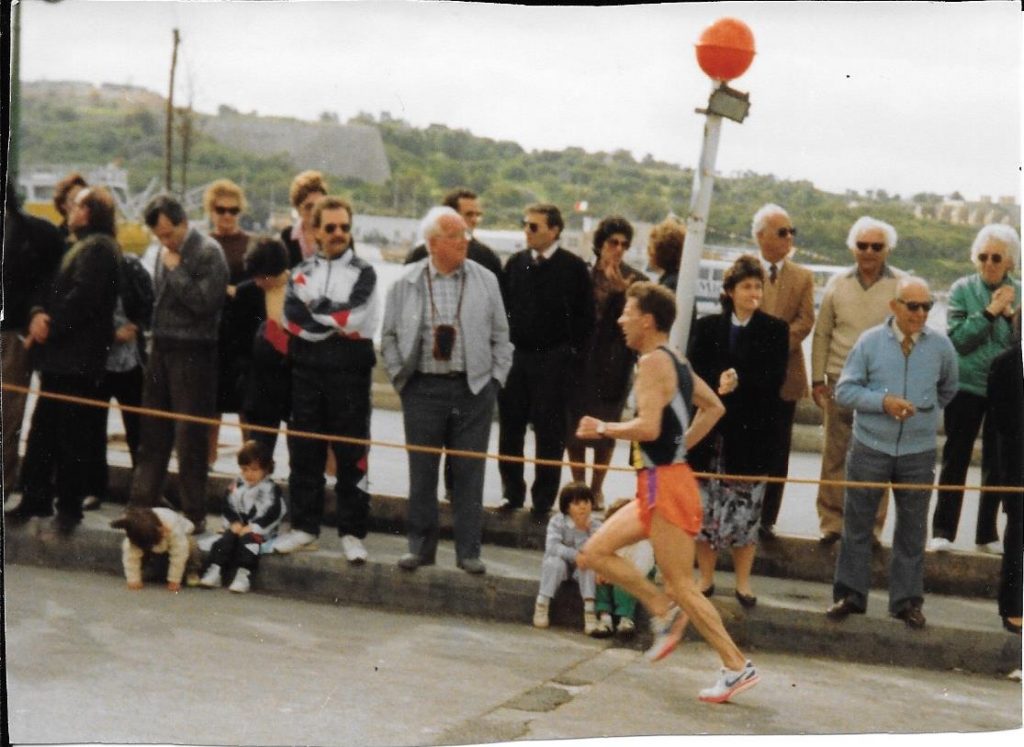
In the Malta Half Marathon, 1992, at age 57 : 1:18:29
Jimmy with the T Shirt for the 2017 Jimmy Irvine 10K Road Race
